Theoretically - if Produttori doesnt make the Crus in a given year (say '12), should I stock up on the normale that vintage, as it will have a much higher % of the cru juice than normal? (it’ll be made to a higher standard/better QPR)
Wonderful, evocative notes, and great pictures. Thanks, Howard.
I bought a couple of bottles of this in 2007. One bottle opened in 2010 was very much as you describe your bottle. Like you, I found it surprisingly advanced but pleasing. My notes say: “Surprisingly brown, classic nebbiolo nose, but quite autumnal in the mouth. 90 points.” Another bottle the next year was much fresher, though quite ready to drink.
I think it depends on the reason they don’t bottle the single vineyards.
As I recall, everything went into the normale in 2006 because there was too much single-vineyard inventory in the pipeline and they didn’t think they could sell another vintage of single-vineyard wines, even though it was a good vintage. But it got more complicated because there were multiple lots of the 2006. Some were bottled early from wine they had always intended for the normale, before they decided not to bottle the crus. Some later lots were composed exclusively of wine originally meant for single-vineyard bottlings, as I recall. (There was a very long thread as a bunch of us tried to sleuth out which lots were which, and there was lots of inconsistent information.)
In 1998, there were no cru bottlings because the quality wasn’t consistent across the vineyards and the coop rules mandate that they bottle all the crus or none.
I’m a bit surprised that they didn’t bottle them in 2010. Perhaps that was again because of an oversupply of the single-vineyard bottlings from prior vintages.
In 2012 it sounds like it may have been a quality issue, so that the normale might not be any better than an ordinary normale vintage (which is pretty darned high and consistent).
Julian, for myself, I wouldn’t particularly chase non-Riserva vintages of Normale. A good vintage lifts the Normale, even if there’s less Riserva fruit. I think 2013 v 2012 is an example of this. Mainly of course I’d try before I bought big on any vintage.
VISIT TO GIUSEPPE MASCARELLO WITH ELENA MASCARELLO - Monchiero, Piemonte
From the outside, you wouldn’t pick it as one of the world’s great wineries. Mauro Mascarello’s winery is located next to a railway line in Monchiero and looks, from the outside, like an engineering light industrial building. Our visit was with Elena, Mauro’s daughter.
Elena showed us around the winery. The winery is small and utilitarian, with cement vats and large format Slavonian oak casks. The wine making is very traditional including long macerations (for the Monprivato average of 30 days).
Elena mentioned that the 2010 Ca d’Morissio Monprivato Riserva is to be released in 2018.
We tasted three wines …
-
2011 Giuseppe E Figlio Mascarello Barbera d’Alba Superiore Scudetto - Italy, Piedmont, Alba, Barbera d’Alba Superiore
Deep, bright colour. A ripe, fine nose of black cherries, blackberries, menthol and liquorice. In the mouth, reflecting the warm 2011 vintage, very ripe, with tons of dark fruit, some spices and a little liquorice. Very open, fat and generous. A powerful, unctuous, opulent Barbera. You could question the lack of acidity and high alcohol (15% on the label). It is a blockbuster but I thought it was in good balance. A good Barbera for earlier drinking. -
2013 Giuseppe E Figlio Mascarello Langhe Freisa Toetto - Italy, Piedmont, Langhe, Langhe DOC
A small cuvee, only 1,500 bottles made. Aged 24 months in botte. Vines 30 years old. A savoury, fresh and breezy bouquet of blackberries and other dark fruit. On palate, drier than expected, particularly after the Barbera. Good, racy acids. Blackberries and kirsch. A serious tannic spine and good length. Not at all rustic. Cellar for 3 + years for the acids to integrate and the tannic grip to loosen. -
2010 Giuseppe E Figlio Mascarello Barolo Monprivato - Italy, Piedmont, Langhe, Barolo
Bright ruby. Perfumed, beautiful bouquet of rose petals, violets, spices, black cherries and other dark fruit with a hint of minerals in the background. On palate, elegant, with silky tannins and lovely balance. Tight. Very closed and austere at its core. The satiny tannins, below medium weight and sense of fruit sweetness of this wine could make you think it is a relatively simple wine. But that’s not my impression. It reminded me of a very young Grand Cru Burgundy. Closed and austere and looking a little unidimensional at the moment but with all of the necessary components held in reserve, I believe, to blossom into a great wine. Hold for 7-10 years.
That evening I walked across the road from our Castiglione Falletto accommodation to the Monprivato vineyard. It was 8.30 pm and the vines were getting the last of the evening sun (it has a favoured south-westerly exposure). The six hectare monopole is a high site (280 metres above sea level). The soil is whitish/gray in colour, a combination of silt, marl, clay and limestone, that gives the wine much of it’s elegance. Most of the vines were planted in the 1960s through to 1996.
Posted from CellarTracker
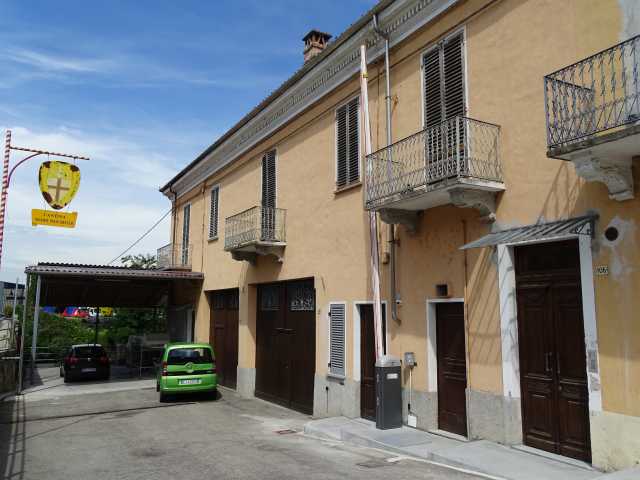
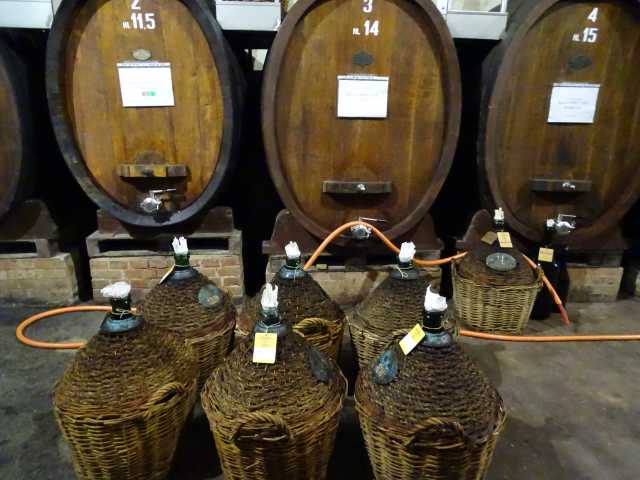
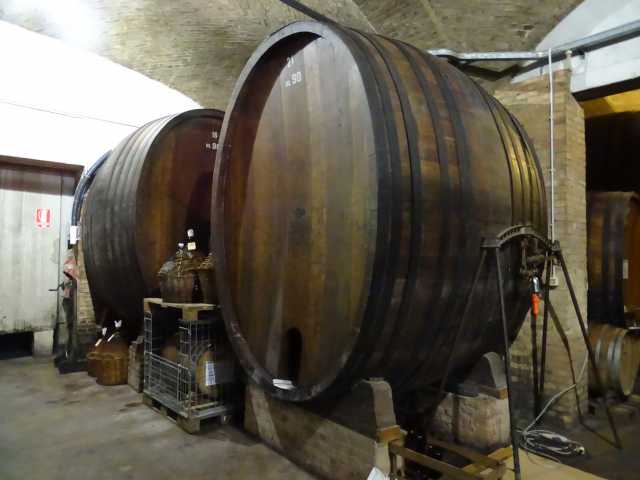
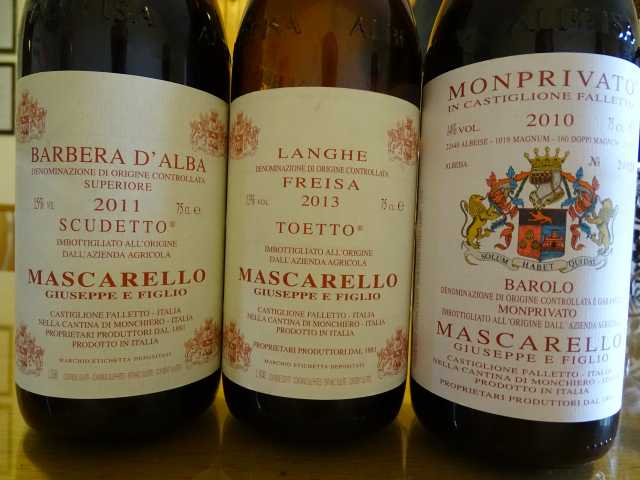
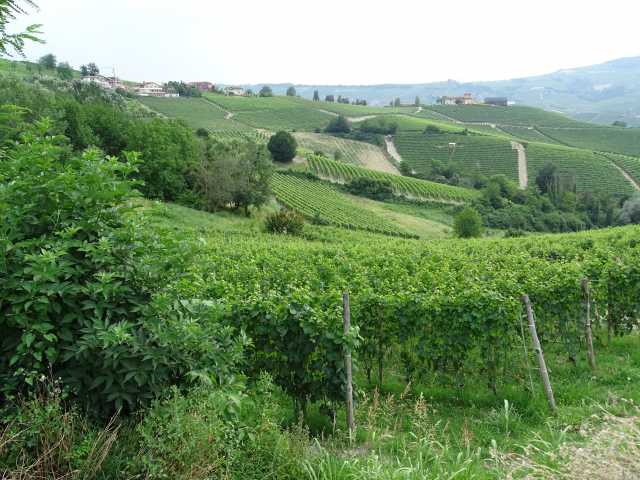
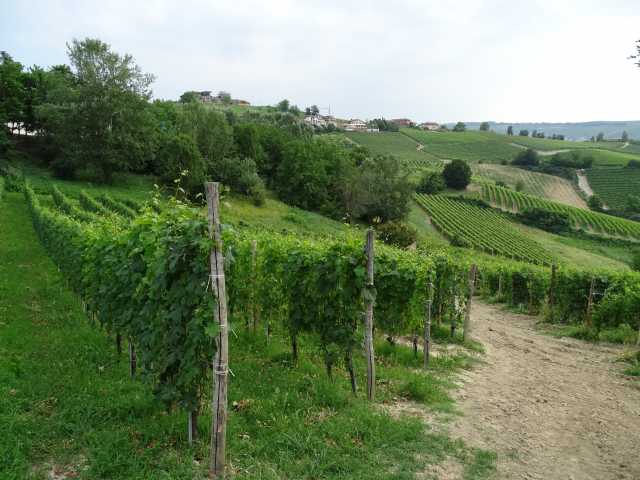
Thanks for posting Howard, these notes and photos are fantastic! You’re killing me though, I’m sitting here in the office at 9am reading this and salivating… One quick question, in the 4th post in the thread you’ve got a photo with a 1974 Produttori Barbaresco bottle in it. Do you have any notes for that bottle? I ask as I’ve got the 1971 and would love to know your thoughts regarding where the 1974 is at the moment. And for the record that plastic bottle wrapping in the same photo looks mighty familiar! ![]()
Great note Howard! I’m a big fan of the 10 Monprivato and do expect it to be a great wine in 10-20 years…
Thanks so much for the wonderful notes and photos!
Thanks everyone for your kind comments.
John, I should have said earlier, regarding older Brovias, I was talking with a friend who had a similar experience a few years ago with a couple of browning late 1980s Brovias. Perhaps there were some issues with the winemaking in those years?
Andrew, the 1974 Produttori note is to come … In short, it showed really well …
Thanks Howard. That’s excellent news, obviously I was hoping you’d say that!
A good video from the Vajra site: G.D. Vajra - Barolo e vini delle Langhe
VISIT TO G.D. VAJRA WITH FRANCESCA VAIRA - Vergne, Barolo
I’m a fan of G.D. Vajra’s wines. I remember well the tasting of the 2010 Vajra and Baudana Baroli. Once all of the Baroli were poured in front of me, the aromas alone were amazing!
After a tour the winery with Francesca, we went to a good tasting which, unsurprisingly for the vintages, never quite reached the heights of the 2010s …
-
2015 G.D. Vajra Langhe Riesling Petracine - Italy, Piedmont, Langhe, Langhe DOC
Primarily from the Fossati site with limestone, gravel and white soil, said Francesca. A pale, greenish tinge to this Riesling. The bouquet quite malic, a mix of green apple, lime juice and minerals. Malic on palate, with bright acidity. As well as green apple and some melon and tropical fruit nuance, there is flint and chalk in the background. A nice and dry Riesling, but very young of course. Give it 2-3 years to settle down a bit. 13% alcohol. -
2013 G.D. Vajra Barbera d’Alba Superiore - Italy, Piedmont, Alba, Barbera d’Alba Superiore
In my opinion, the Vajra is one of the top Barberas in all of Piemonte, not far below the G Conternos and Viettis … From vines of 35+ years age said Francesca. She said “Bricco delle Viole fruit provides verticality, while Bricco Bertone provides power”. Macerated around 30 days, aged in large oak casks. This is another good vintage, up there with the 2008 in quality … Iridescent purple-red in colour. Dark to blue fruit on bouquet, musk and Asian four spice. In the mouth, a serious Barbera, that combination of the verticality and power Francesca described. Succulent, crunchy dark fruit and liquorice. Seamless and concentrated with minerality on the finish. You could cellar this wine long term, I’d guess, but give it 2-3 years, minimum. -
2012 G.D. Vajra Barolo Bricco delle Viole - Italy, Piedmont, Langhe, Barolo
From the high altitude (400 metres) vineyard in front of the winery (with a lot of wind and light), south facing, with vines up to 65 years old. Around a 35 day maceration, Slavonian botte used. Bright red berry fruit and limestone on the nose, quite fresh. A precise and linear Barolo in the mouth. Good volume, it expands on the mid palate. Velvety texture with chalky tannins. Elegant with slight austerity. Unsurprisingly, quite tight and a little closed. A good but not a great example of this Cru. -
2012 G.D. Vajra Barolo Ravera - Italy, Piedmont, Langhe, Barolo
From a vineyard, Francesca explained, in the amphitheatre just below Cogno’s plot, with vines never less than 20 years age, some 40+ years and the rest 65+ years old. A step up here. A noticeably darker and darker spiced nose. More generosity and fruit volume on palate. Good weight. Spicy, not chalky tannins. Very good. This wine will need 4-7 years in the cellar, I’d think. -
2012 Luigi Baudana Barolo Baudana - Italy, Piedmont, Langhe, Barolo
G.D. Vajra now owns Luigi Baudana and makes these wines. A spicy, more red fruited nose. For me, a lesser Barolo than the two Vajra Baroli. Lighter bodied with gentle tannins, but a little more structure on the finish. Quite pretty and reasonably generous with good acidity. -
2012 G.D. Vajra Langhe Freisa Kyè - Italy, Piedmont, Langhe, Langhe DOC
A noticeably breezier, more wild nose, with calcium traces. Quite a pure wine with Smooth, suave tannins, minerality and more racy acids than the 2012 Baroli. Lighter bodied, quite elegant. An earlier drinking wine but would cellar, I would think. -
2014 G.D. Vajra Moscato d’Asti - Italy, Piedmont, Asti, Moscato d’Asti
To finish, a good, hedonistic Moscato with a nose of lemon pie and clotted cream. Frothy and fun on palate with similar flavours and creamy creme brûlée. From 45 year old vines, 5.5% alcohol.
Posted from CellarTracker
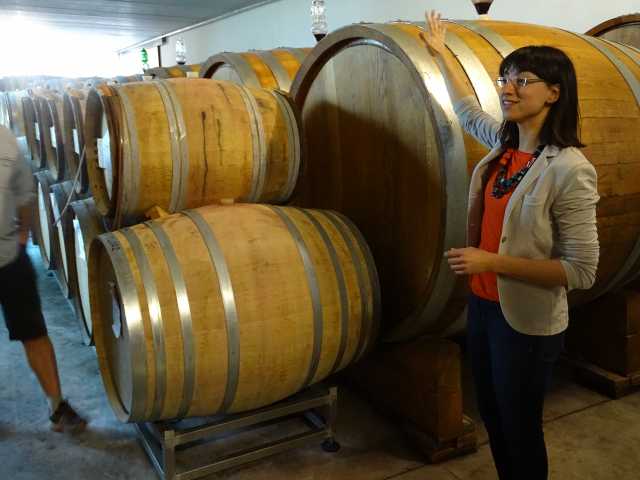
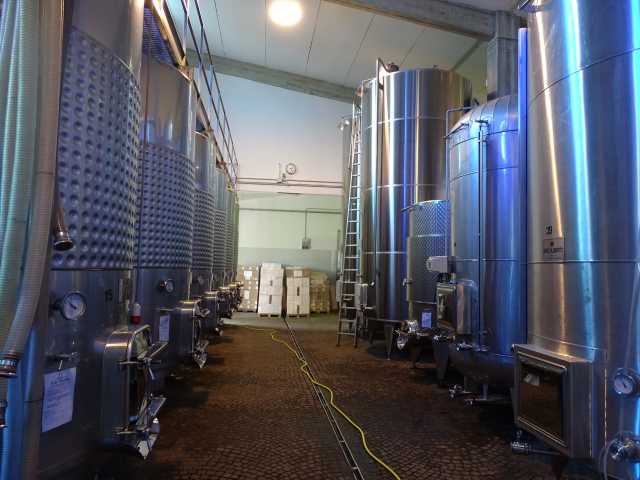
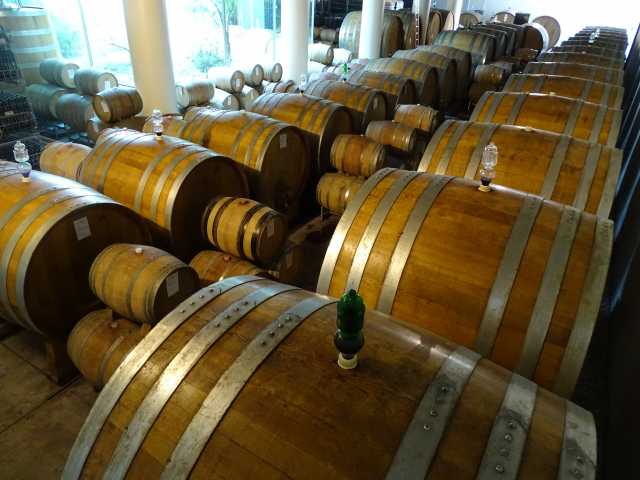
VISIT TO GIUSEPPE RINALDI WITH MARTA RINALDI - Barolo, Piemonte
After the visit yesterday to G Mascarello, today was a visit to a second traditionalist powerhouse: Giuseppe Rinaldi.
On the way in to our appointment with Marta we heard a familiar accent in the winery and met a Kiwi, Tom Meyers, who was working there.
Marta explained that Rinaldi has 6.5 ha under vines and has four Barolo Crus: Brunate (1 ha), Le Coste (0.5 ha), Cannubi (San Lorenzo, very small) and Ravera (3 ha). Rinaldi produces about 38,000 bottles a year, including about 16,000 bottles of Barolo, as well as Nebbiolo Langhe, Barbera and Freisa (about 2,000 bottles).
They produce two Baroli, the Brunate (typically 85% Brunate and 15% Le Coste) and the Tre Tine (a blend of about 60% Ravera, 20% Cannubi and 20% Le Coste).
The wines are made as organically as is possible: using only a little copper and sulphur. The Nebbiolo grapes are fully destemmed and given a long maceration (~ 30 days on skins) in large open topped oak barrels at a natural temperature. Natural yeasts are used. Pumping over is typically two times per day.
Marta said that the aim is to make a clean Barolo (adding only some sulphur).
Only large Slavonian oak casks are used. Rinaldi racks only about 4-5 times in three years, said Marta.
-
2015 Giuseppe Rinaldi Dolcetto d’Alba - Italy, Piedmont, Alba, Dolcetto d’Alba
Made in stainless steel. A crisp, expressive nose of wild blackberry fruit and fresh herbs. On palate, dark cherry and blackberry. Rounded, seemingly lower acidity. Rich and opulent. Quite powerful for a Dolcetto. I’d imagine you could cellar this wine, but it’s ready to go now. A good quality Dolcetto. -
2015 Giuseppe Rinaldi Freisa Langhe - Italy, Piedmont, Langhe, Langhe DOC
From 20 year old vines in Ravera, said Marta. Even just on bouquet, there is a greater sense of acidic structure. A breezy bouquet of black cherry and other dark fruit, with a touch of blue fruit, and fresh herbs. That acidity is definitely there on palate, the wine lighter bodied, a little rustic with some crunchy fruit. Angular and slightly wild, with a hint of spritz. I thought it was great! -
2014 Giuseppe Rinaldi Nebbiolo Langhe - Italy, Piedmont, Langhe, Langhe DOC
Raspberry, red cherry and other red fruit, spices and meadow flowers. Subtle and elegant red fruit on palate. Good acidity. Below medium weight. Not complex, but an enjoyable, straightforward wine for earlier drinking. At least at this tasting, it seemed a lesser wine. -
2012 Giuseppe Rinaldi Barolo Tre Tine - Italy, Piedmont, Langhe, Barolo
A blend of 60% Ravera, 20% Cannubi (San Lorenzo) and 20% Le Coste. This is a superb, elegant Barolo. A light ruby colour. A perfumed, floral, complex, beautiful bouquet. A refined and very precise wine on palate. Fresh with lovely acidity. Ethereal and finessed. You could mistake this wine for being delicate but there is some power and tannins (albeit spherical and ultra-fine grained ones) under the surface. Despite this profile, I’d imagine the Tre Tine should really be cellared for 8-10+ years. However, it is a dangerously tempting wine to open in the first year or two, if you have a spare bottle. -
2013 Giuseppe Rinaldi Barolo Brunate - Italy, Piedmont, Langhe, Barolo
To be released in April 2017. From the barrel. A darker, deeper colour. A serious bouquet, closed and austere. Dark and a little earthy with a little balsamico. On palate, a satiny texture. Seamless, suave tannins. Dense, weighty black fruit, with serious grip on the back palate. This is what Barolo is all about. A superb, classic Barolo to cellar.
Posted from CellarTracker
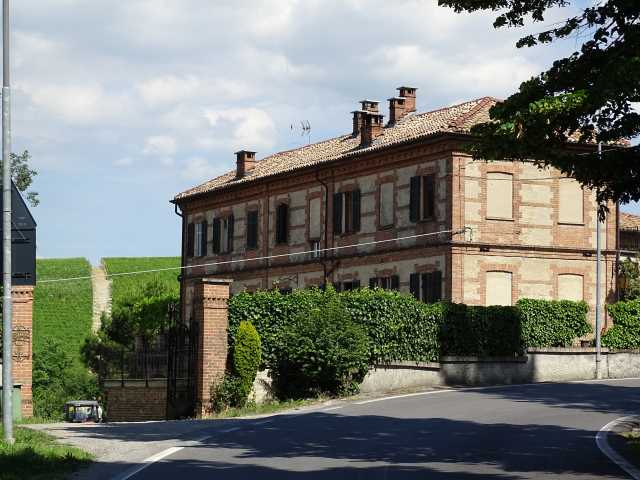
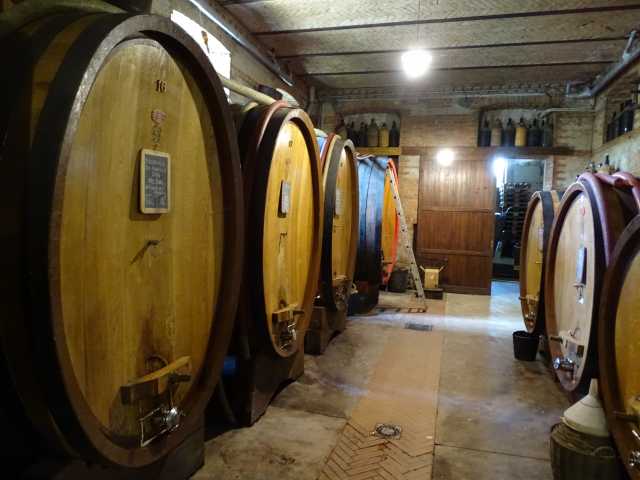
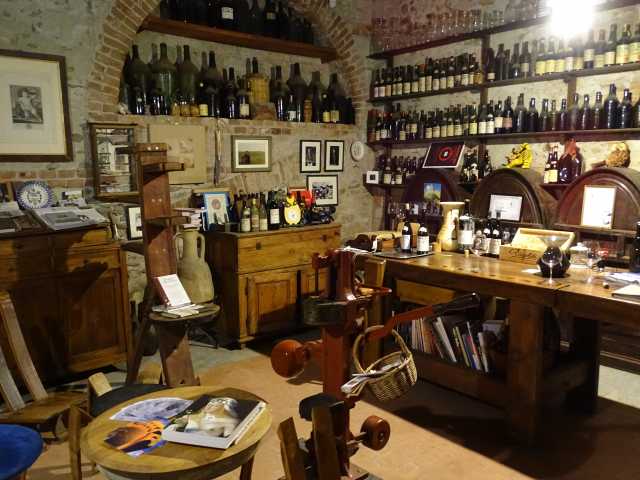
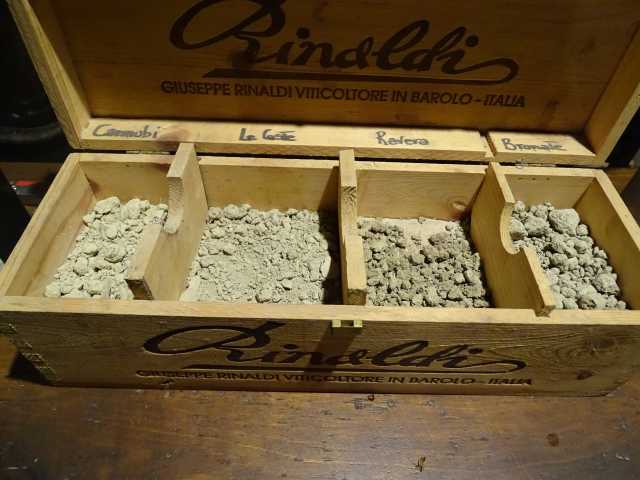
The dark green vineyard is Brunate, below La Morra, photographed from Castiglione Falletto. At Marcarini, Brunate was said to have possibly taken its name from the Piemontese word for “dew”. It is a high site (230 to 405 metres) and an amphitheatre, subject to diurnal temperature changes, that can give the wines freshness.
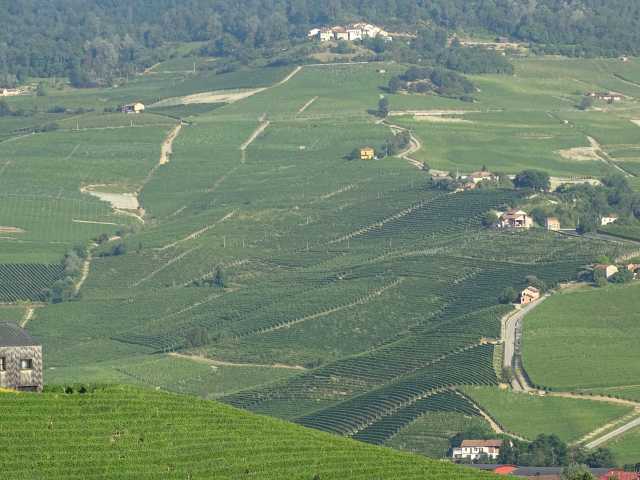
MARCHESI DI GRÉSY WITH JEFFREY CHILCOTT - Martinenga, Barbaresco
Jeffrey Chilcott of Marchesi di Grésy is a Kiwi who has long lived in Piemonte. He’s also a top bloke and great host for a tasting or a dinner.
Marchesi di Grésy has a monopole vineyard - Martinenga - on the ‘Grand Cru’ hill in Barbaresco, at 280 metres. Vigna Camp Gros (the “s” is pronounced) is on the right of the winery (below Rabajà) and has a southwest exposure. Vigna Gaiun is on the left, below Asili, and is direct south. The Camp Gros is aged largely in Slavonian 12.5HL oak casks, while the Gauin is aged in French barriques (around one-third new).
As always with Jeff, the evening tasting at the winery was a bit of a flurry of bottles … Here’s the highlights …
-
2015 Tenute Cisa Asinari dei Marchesi di Grésy Langhe Nebbiolo Martinenga - Italy, Piedmont, Langhe, Langhe DOC
Marchesi di Grésy’s Langhe Nebbiolos see no oak, only steel and cement. Bright colour. Fresh red fruit on the nose. Good varietal character. Generous with lots of fruit. Refreshing with good acidity (“We pick a little earlier now”, said Jeff). These wines are 15 euros at the winery, good value. -
2014 Tenute Cisa Asinari dei Marchesi di Grésy Langhe Nebbiolo Martinenga - Italy, Piedmont, Langhe, Langhe DOC
A lighter colour and a bouquet of spicy red fruit. With time in the bottle, this wine seems to have put on a little weight, compared with the '15. Good fruit, for this level. Nice texture. A little savoury and spicy. “A junior Barbaresco Camp Gros”, said Jeff. -
2013 Tenute Cisa Asinari dei Marchesi di Grésy Barbaresco Martinenga - Italy, Piedmont, Langhe, Barbaresco
To be released in September or October 2016. Violets and other florals on the bouquet with dark cherries and other black fruit and a little tar. Again for the level, a really good Barbaresco. Fresh 2013 acids with a good volume of mainly dark fruit, peaty soil and creosote. -
2012 Tenute Cisa Asinari dei Marchesi di Grésy Barbaresco Martinenga - Italy, Piedmont, Langhe, Barbaresco
Nice aromatics here too but more in the spectrum of red cherries, raspberries and other red fruit, with some spices. More red fruited on palate too, with less acidity and cut than the '13. Less concentration and a leaner, gentler version of the 2013, which I preferred. -
2011 Tenute Cisa Asinari dei Marchesi di Grésy Barbaresco Martinenga Gaiun - Italy, Piedmont, Langhe, Barbaresco
Deep, primary, purple tinged colour. An expressive tarry nose with Asian black spices and blackberry jam. A big step up from the Martinengas. Opulent and rich in the mouth. Concentrated black cherries, blackberries and liquorice. Plenty of structure and fruit weight. The impression of lower acids. A little cassis-like alcohol present on the back palate (14.5%). Suave, smooth tannins. Hold for 5+ years for the wine to more fully integrate. “It was picked two weeks earlier than the 2010 Gaiun”, said Jeff. -
2010 Tenute Cisa Asinari dei Marchesi di Grésy Barbaresco Martinenga Gaiun - Italy, Piedmont, Langhe, Barbaresco
A great nose. An expressive perfume of spices, florals, liquorice and balsamico. On palate, more of a classical Nebbiolo than the '11 Gaiun. Less rich and luxuriant, more vertical and linear. Still there’s plenty of dark fruit here and touches of cedar and spice. Attractively austere and iron-like at its core. Medium weight only with good bones and acidity. Lower alcohol (14%). Good length. I’d give it more cellar time than the '11. Better than the '11, I thought. -
2010 Tenute Cisa Asinari dei Marchesi di Grésy Barbaresco Martinenga Camp Gros - Italy, Piedmont, Langhe, Barbaresco
For me, the wine of the tasting (although hard to compare with the fully mature 1993). Light ruby colour. A Rabajà-like bouquet of griotte cherry, kirsch, strawberries and new leather. Distilled cherries also on palate, the impression of some fruit sweetness. Plums, strawberries, tobacco and spices. Satiny texture with softer tannins than the Gaiuns. Good architecture. Fine grained tannins. Complex and detailed with good length. I wouldn’t open this wine for 3-5+ years. -
2005 Tenute Cisa Asinari dei Marchesi di Grésy Barbaresco Martinenga Gaiun - Italy, Piedmont, Langhe, Barbaresco
A darker colour here, with aromas of tar, menthol, bonfire, dark soil and black fruits. On palate, very dark fruited, with cacao, tar and smokey meats. There is a lot of structure and good volume and acids, with serious grip on the back. The tannins are spherical but the wine is still a little monolithic and closed. I’d hold it for a minimum of 3+ more years. -
1993 Tenute Cisa Asinari dei Marchesi di Grésy Barbaresco Martinenga Gaiun - Italy, Piedmont, Langhe, Barbaresco
Served blind but some age clearly apparent. A little musty, with earthy and sottobosco aromas. Also a Campari, orange skin character, I sometimes see in older Nebbioli. Almost an older Pinot Noir-like nature to the bouquet. After some initial fruit sweetness on palate, a beautifully integrated and mature Barbaresco. I guessed it as a 1998 Gaiun, as I saw some 1998-like richness and Gaiun character. Secondary notes of smoked meats, dry underbrush, cigar, figs and dried red fruits. Jeff described 1993 as “an in-between year” in Barbaresco. I thought that this wine competed in quality with the recent 1993 Sperss we drank. Drink or hold for a few more years.
Posted from CellarTracker
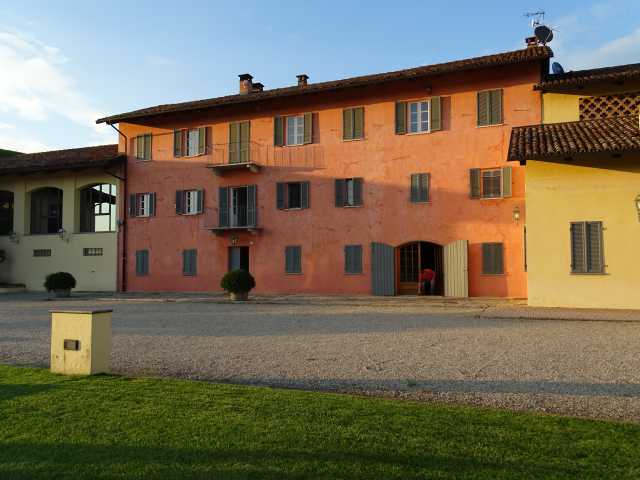
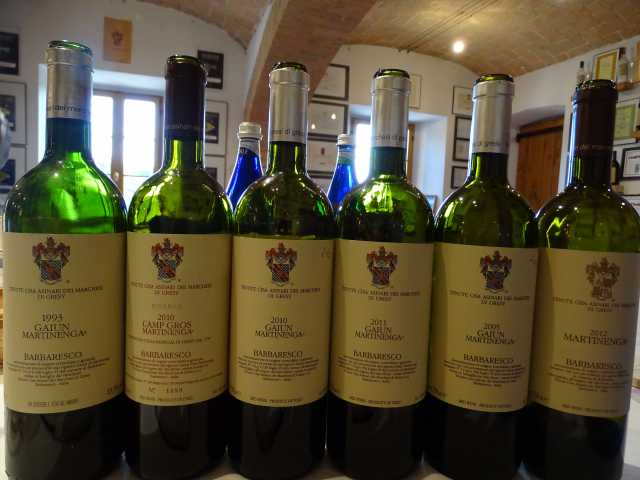
DINNER WITH JEFFREY AND ALBERTO AT THE OSTERIA DEI SOGNATORI, ALBA
Andrew, Thierry and I joined Jeffrey and Alberto di Grésy at the excellent, lively Osteria Dei Sognatori in Alba.
We had brought our own wines and warmed up with an excellent 2013 Vigneti Boveri Giacomo Timorasso Berthona. It had a chalky, steely Chablis-like quality on the nose and lovely, bright acidity on the palate. It was refreshing and well focussed with chalky and steely flavours and touches of honey. “Mineral in the mouth and always clean” said Jeffrey.
Next was Jeff’s 2011 Azienda Agricola Bera Rabajà Riserva. He said that Bera had only recently bought a plot in Rabajà. It had seen only neutral oak. It was fragrant and aromatic with plenty of dark berries and violets on bouquet. Very young, it also showed dark, luxuriant fruit on palate, with serious, grippy tannins on the back. “Cherries under spirit” said Jeff.
Next we drank …
-
2005 Weingut Knoll Grüner Veltliner Smaragd Loibenberg - Austria, Niederösterreich, Wachau
Jeff brought this excellent Gruner. Some reduction on opening. A beautiful, complex bouquet of white pepper, mint, mixed herbs, nuts and smoke. Viscous, honeyed, complex and nutty in the mouth. Not a lot of acidity, but mineral and malic, ripe and rich. Clean and pure. Very good. There now for drinking. -
2009 Tenute Cisa Asinari dei Marchesi di Grésy Barbaresco Martinenga - Italy, Piedmont, Langhe, Barbaresco
Jeff introduced the 2009 as “drinking the best of the Marchesi di Grésy wines at the moment”. Great aromatics of luxuriant, ripe dark fruit and florals. Linear on palate. Sleek, satiny dark fruit, cassis and liquorice. Soft, refined tannins. A wine to drink sooner rather than later, I’d think. -
1995 Vietti Barolo Lazzarito - Italy, Piedmont, Langhe, Barolo
Popped and poured. Light colour. Beautiful aromatics. Roses, red currants, dried brushwood and gentle spices. Sweet entry, then elegant and fresh with soft, mellowed, round tannins. Earthy with dried red fruit. Just a beautiful, mature Barolo. Both Jeff and Alberto picked it as a '98 Barbaresco (and it showed the refinement of a top quality Barbaresco). It paired very well with the butter and sage ravioli. Finishing the last glass the next day, it was still drinkable but the fruit had slipped away a little, exposing the acids. Not a wine for a long decant. -
1974 Produttori del Barbaresco Barbaresco - Italy, Piedmont, Langhe, Barbaresco
Popped and poured. Initially wet wool and hay, then lavender, dry earth, dried and preserved red fruit and some citrus zest. In the mouth, a gorgeous, mellow, mature Nebbiolo. “Very composed” said Jeff, it was very poised and balanced. Earthy with cacao, orange peel and Campari. Some fruit sweetness but attractive mushroomy savouriness and Balsamico umami. Acidity and tannins well integrated. Lovely but a modest wine (“Franco” said Alberto). Jeff thought it was from the 1980s and Alberto the 1970s, but neither went back as far as 1974. Jeff said it was the freshest 1974 he had ever had. I mentioned the bottle to Aldo Vacca who was not surprised, describing 1974 as a “good, powerful vintage” from which many Normales were still drinking well.
We left the Osteria happy to go out to enjoy the Alba street party …
Posted from CellarTracker